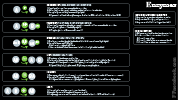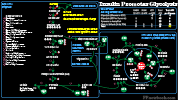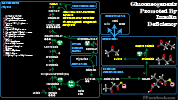II. Definitions
- Chemical Reaction
- Chemical change in which two or more substances are modifed to result in one or more new substances
- Reactions affect the rearrangement of atoms or molecules
- Results in substances with different properties from the original substances
- Thermodynamics
- Energy relationships between different states of a system
- Properties (heat, work, Temperature, equilibrium) affect the conversion from one state to another
III. Physiology
- Thermodynamics
- Energy is conserved (First Law of Thermodynamics)
- Energy is equivalent on each side of a chemical equation
- Entropy (Second Law of Thermodynamics)
- Natural, normal progression and breakdown from a state of order to one of disorder and randomness
- Measured as the amount of heat or energy unavailable to do work
- Examples: Heat flows to colder regions, Chemical Reactions favor energy loss
- Energy is conserved (First Law of Thermodynamics)
- Chemical Reaction
- Reaction Direction
- Reactions follow pathways of net energy loss or release, and stable substances with stronger bonds
- Higher substance concentration also impact reaction direction (toward decreasing concentration)
- When reactions involve a cascade of sub-reactions, the net result is energy loss and stability
- Complex biosynthesis in organisms (including humans) requires significant energy loss
- Two-way reactions typically involve different mechanisms and enzymes for the different directions
- In vivo reactions are limited to the cells that contain the needed substrates and enzymes
- Many reactions are limited to certain tissues (e.g. liver, Muscle)
- Only one reaction direction is typically active at one time (to prevent wasted activity)
- For example, Glycolysis and Gluconeogenesis do not occur simultaneously
- Biosynthesis of a substance often occurs in different organs than its biodegradation
- Simultaneous, bidirectional reactions result in wasted energy, typically lost as heat
- Reaction Rate
- Rate is largely determined by the energy needed to trigger the reaction (energy of activation)
- Rate increases with warmer Temperatures and higher substrate concentrations, and when enzyme facilitated
- Rate decreases with colder Temperatures and higher reaction product concentrations
- Rate is independent of the potential energy loss from a given reaction
- Reaction Direction
- Substrate
- Substrate concentration depends on multiple factors
- Rate of substrate precursor uptake (e.g. diet) versus excretion
- Substrate biosynthesis rate from precursors
- Substrate entrance into the cell (e.g. receptor-mediated)
- Substrate concentration depends on multiple factors
- Enzymes (Proteins) and Ribozymes (RNA) facilitate Chemical Reactions
- Lower the energy of activation for a specific reaction, significantly speeding (catalyzing) the overall reaction
- Reactions are often built from multiple sub-steps of cascading enzyme activation
- Example: Clotting Pathway
- Enzyme efficiency is impacted by several factors
- Substrate concentration
- Enzyme concentration
- Enzyme amount in the active state (in contrast to its inactive precursor state or Zymogen)
- Feedback regulation
- Enzyme Categories

- Oxidoreductases (Redox Reaction, e.g. dehydrogenase, reductase enzymes)
- Transfer electrons from one molecule to another
- Molecules lose electrons in oxidation, and gain electrons in reduction
- Example: Pyruvate dehydrogenase (Glycolysis)
- Pyruvate is oxidized to Acetyl Coenzyme A.
- Transferases (e.g. synthase enzymes, kinase enzymes, transferase enzymes)
- Functional groups are transferred from one molecule to another
- Example: Phosphotransferase (Glycolysis)
- Hydrolases (e.g. amylase, Lipase, Beta Lactamase)
- Break apart covalent bonds (and molecules) with the use of water (hydrolysis)
- Example: Fumerase (TCA Cycle)
- Fumarate is catalyzed to Malate
- Fumarate's double bond becomes a single bond, as hydroxide is added
- Lyases (e.g decarboxylase, cyclase)
- Dissociates or breaks apart molecules
- Performed without water (unlike hydrolases), or oxidation/reduction (Redox Reaction)
- Example: Aldolase lyses Fructose-1, 6-bisphosphate into 2 products (Glycolysis)
- Glyceraldehyde-3-phosphate
- Dihydroxyacetone phosphate
- Isomerases
- Rearrange molecular bonds, creating an isomer (same chemical formula, different arrangement)
- Example: Phosphoglucomutase (Glycolysis)
- Ligases
- Join molecules together, creating covalent bonds
- Example: Pyruvate Carboxylase (Gluconeogenesis)
- Catalyzes pyruvate to oxalocetate in the mitochondria (costing 1 ATP and bicarbonate)
- Images
IV. References
- Goldberg (2001) Biochemistry, Medmaster, Miami, p. 4-12, 28-9


